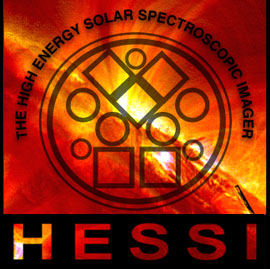|
Sun & Space Weather News 2009
[Current News] [2009 Archive] [2008 Archive] [2007 Archive]
[2006 Archive] [2005 Archive] [2004 Archive] [2003 Archive]
| 5/5/09 |
|
In the most recent STEREO data from the "behind" spacecraft, there is a large new solar cycle active region (associated with a sunspot) at the east limb that has produced an impressive Coronal Mass Ejection. The event begins about 08:15 Universal Time in the Extreme UltraViolet (EUV) instrument. This is the first unambiguous CME associated with a radio burst (known as type II burst) that the STEREO spacecraft radio antennae (S/WAVES instrument suite) have detected since March of last year. Maybe solar minimum is finally over! |
| |
|
|
| 4/25/09 |
|
UNEXPECTED SOLAR ACTIVITY: The sun produced an unexpected burst of activity on April 23rd when an enormous prominence rose over the northeastern limb and erupted. A coronal mass ejection (CME) billowed away from the blast site, but the billion-ton cloud is not heading toward Earth. Visit http://spaceweather.com for movies of the event. |
| |
|
|
| 4/02/09 |
|
SPOTLESS SUNS: Yesterday, NASA announced that the sun has plunged into the deepest solar minimum in nearly a century. Sunspots have all but vanished and consequently the sun has become very quiet. In 2008, the sun had no spots 73% of the time, a 95-year low. In 2009, sunspots are even more scarce, with the "spotless rate" jumping to 87%. We are currently experiencing a stretch of 25 continuous days uninterrupted by sunspots--and there's no end in sight.
This is a big event, but it is not unprecedented. Similarly deep solar minima were common in the late-19th and early-20th centuries, and each time the sun recovered with a fairly robust solar maximum. That's probably what will happen in the present case, although no one can say for sure. This is the first deep solar minimum of the Space Age, and the first one we have been able to observe using modern technology. Is it like others of the past? Or does this solar minimum have its own unique characteristics that we will discover for the first time as the cycle unfolds? These questions are at the cutting edge of solar physics.
You can monitor the progress of solar minimum with a new "Spotless Days Counter" on spaceweather.com. Instead of counting sunspots, we're counting no sunspots. Daily updated totals tell you how many spotless days there have been in a row, in this year, and in the entire solar cycle. Comparisons to historical benchmarks put it all in perspective. Visit http://spaceweather.com for data. |
| |
|
|
| 2/13/09 |
|
VALENTINE'S AURORAS: Arctic sweethearts, take note. A solar wind stream is heading toward Earth and there is a 35% chance of geomagnetic activity when it arrives on Feb. 14th. Valentine's Day could end with a sweet display of Northern Lights: gallery. |
| |
|
|
| |
|
|
|
|

RHESSI
How energy is released in flares on
the Sun

STEREO/IMPACT
How Coronal Mass Ejections
from the Sun erupt and propagate through the solar wind

THEMIS
What makes the aurora erupt
globally? The substorm onset problem

WIND
The solar wind is a dynamic and complex electrified and magnetic gas.
|